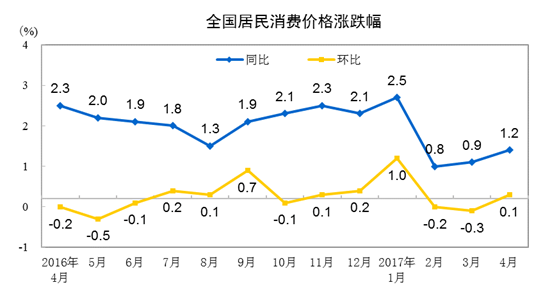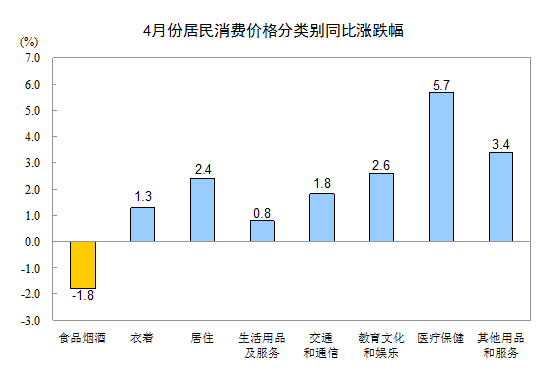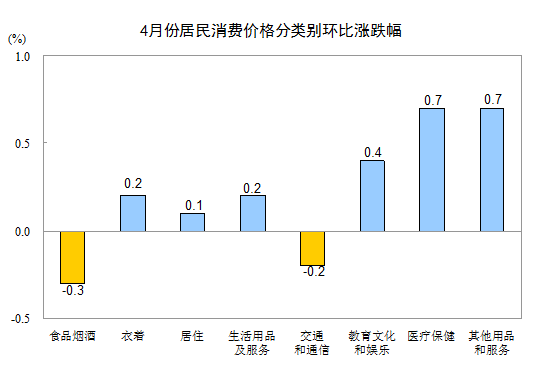In April, 2017, the the general price level of residents nationwide rose by 1.2 percent year-on-year. Among them, cities rose 1.3%, rural areas rose 0.8%; Food prices fell 3.5%, non-food prices rose 2.4%; Consumer prices rose 0.2%, service prices rose 2.9%. From January to April, the average number of residents nationwide increased by 1.4% the general price level over the same period last year.
In April, the number of residents nationwide rose 0.1 percent from the general price level month on month. Among them, the city rose 0.1%, the rural area was flat; Food prices fell 0.6%, non-food prices rose 0.2%; Consumer prices fell 0.1%, service prices rose 0.4%.

I. Year-on-year changes in prices of various commodities and services
In April, the price of food, tobacco and alcohol decreased by 1.8 percent year-on-year, affecting the CPI drop by about 0.56 percent age points. Among them, the price of fresh vegetables decreased by 21.6 percent, affecting the CPI drop by about 0.65 percent age points; Egg price decreased by 11.4 percent, affecting the CPI drop by about 0.07 percent age points; The price of livestock and meat decreased by 4.6 percent, the impact of CPI decreased by about 0.23 percent age points (pork price decreased by 8.1 percent, and the impact of CPI decreased by about 0.24 percent age points); The price of aquatic products increased by 5.9 percent, affecting the CPI increase by about 0.11 percent age points; fresh fruit prices rose 5.9 percent, affecting CPI rise by about 0.10 percent age points; Grain prices rose 1.5 percent, affecting CPI rise by about 0.03 percent age points.
The prices of the other seven categories increased year-on-year. Among them, the price of medical care rose 5.7%, the price of other supplies and services rose 3.4%, the price of education, culture and entertainment rose 2.6%, the price of living rose 2.4%, transportation and communication, clothing, the prices of daily necessities and services increased by 1.8%, 1.3% and 0.8% respectively.
According to estimates, in the year-on-year increase of 1.2 percent of residents the general price level in April, the price increase last year was about 0.6 percent age points, and the new price increase factor was about 0.6 percent age points.

II. Price changes of various commodities and services on a month-on-month basis
In April, the price of food, tobacco and alcohol decreased by 0.3% month on month, affecting the CPI drop by about 0.09 percent age points month on month. Among them, the price of fresh vegetables decreased by 5.0 percent, affecting the CPI drop by about 0.12 percent age points; The price of livestock meat decreased by 1.2 percent, affecting the CPI drop by about 0.06 percent age points (pork price dropped by 2.0 percent, impact CPI decreased by about 0.05 percent age points); Fresh fruit price rose by 1.9 percent, affecting CPI rise by about 0.03 percent age points; Aquatic products price rose by 1.5 percent, affecting CPI rise by about 0.03 percent age points.
The prices of the other seven categories rose and fell from six. Among them, the prices of medical care, other supplies and services all rose 0.7%, the prices of education, culture and entertainment all rose 0.4%, and the prices of clothing, daily necessities and services all rose 0.2%, housing prices increased by 0.1%; Transportation and communication prices decreased by 0.2%.

1. Indicator explanation
The Consumer Price Index (CPI) is a measure of the relative number of changes in the Price level of Consumer goods and services, comprehensively reflect the changes in the price level of consumer goods and services purchased by residents.
2. Statistical scope
The national consumer price index (CPI) covers the food, tobacco, alcohol, clothing, living, daily necessities and services, transportation and communication, education, culture and entertainment, medical care, there are 8 categories of other supplies and services, with 262 basic categories of commodity and service prices.
3. Investigation methods
The sampling survey method is adopted to select and determine the survey outlets. According to the principle of “fixed person, fixed point and timing”, directly send people to the survey outlets to collect the original price. The data comes from 500 cities and counties in 31 provinces (autonomous regions and municipalities), and about 88000 price survey points, including shopping malls (stores), supermarkets, farmers’ markets, service outlets and Internet e-commerce.
46464
in April, 2017, the the general price level of residents nationwide rose by 1.2% year on year. Among them, cities rose 1.3%, rural areas rose 0.8%; Food prices fell 3.5%, non-food prices rose 2.4%; Consumer prices rose